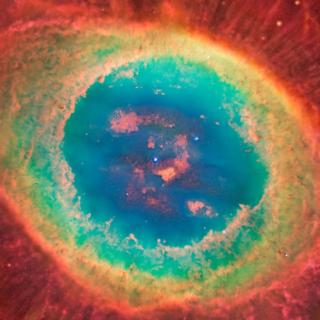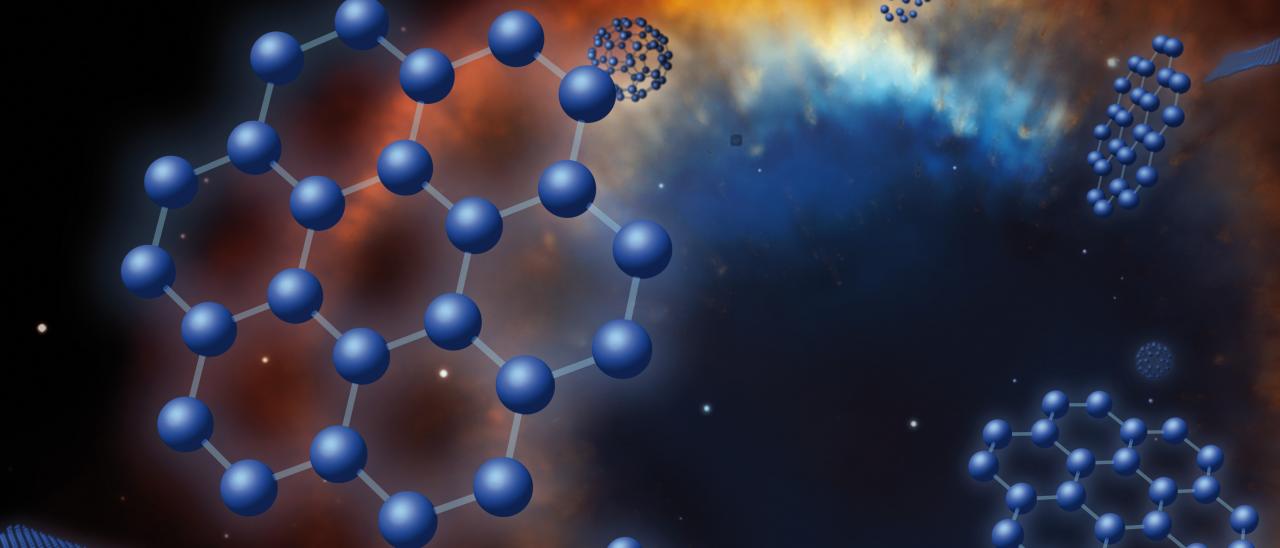Subvenciones relacionadas:
General
Las estrellas de masa baja e intermedia (M < 8 masas solares, Ms) representan la mayoría de estrellas en el Cosmos y terminan sus vidas en la Rama Asintótica de las Gigantes (AGB) - justo antes de formar Nebulosas Planetarias (NPs) - cuando experimentan procesos nucleosintéticos y moleculares complejos. Las estrellas AGB son importantes contribuyentes al enriquecimiento del medio interestelar, donde nacen nuevas estrellas y planetas (incluyendo nuestro propio Sistema Solar Temprano, SST) y a la evolución química de sistemas estelares como cúmulos globulares (CGs) y galaxias. En particular, las AGBs más masivas (M > 4-5 Ms) sintetizan (radio)isótopos muy diferentes de los formados por AGBs menos masivas y explosiones de Supernova debido a los diferentes mecanismos de nucleosíntesis. Las estrellas evolucionadas en la fase de transición entre AGBs y NPs también forman diversos compuestos orgánicos como PAHs y nanoestructuras moleculares de fullereno y grafeno, siendo un maravilloso laboratorio Astroquímico. Colaboraciones astronómicas punteras como SDSS-IV/APOGEE-2 y el próximo telescopio espacial James Webb representan un paso fundamental para entender la nucleosíntesis y los procesos moleculares en estrellas evolucionadas. Se pretende explorar la nucleosíntesis de (radio)isótopos ligeros/pesados en estrellas AGB y como éstas contribuyen a la radioactividad del SST así como a la formación/evolución de CGs y galaxias. También se pretende entender el proceso de formación "top-down" de nanoestructuras moleculares de fullereno y grafeno en estrellas evolucionadas. Finalmente, se pretende realizar minería de datos obtenidos con el satélite Gaia, para estudiar la fase evolutiva AGB-NP, y además utilizar el telescopio espacial GALEX para descubrir estrellas binarias en NPs Galácticas.
Miembros
Resultados
1. Durante 2020, se han publicado 37 artículos en revistas astronómicas internacionales con referee de alto impacto (incluyendo un review invitado), así como 2 artículos en la revista de Química-Física FNCN.
2. Se han descubierto, por primera vez, estrellas muy ricas en fósforo y cuyo patrón químico no es predicho por ninguna teoría actual de nucleosíntesis estelar.
3. Se ha demostrado que las estrellas ricas en fósforo representan un nuevo sitio estelar para la formación de elementos muy pesados, con importantes implicaciones para la evolución química de nuestra Galaxia.
Actividad científica
Publicaciones relacionadas
-
Infrared Spectral Fingerprint of Neutral and Charged Endo- and Exohedral Metallofullerenes
Small metal-containing molecules have been detected and recognized as one of the hybrid species that are efficiently formed in space, especially in the circumstellar envelopes of evolved stars. It has also been predicted that more complex hybrid species such as those formed by metals and fullerenes (metallofullerenes) could be present in these
Barzaga, R. et al.Fecha de publicación:
112023 -
Dust from evolved stars: a pilot analysis of the AGB to PN transition
We present a novel approach to address dust production by low- and intermediate-mass stars. We study the asymptotic giant branch (AGB) phase, during which the formation of dust takes place, from the perspective of post-AGB and planetary nebula (PN) evolutionary stage. Using results from stellar evolution and dust formation modelling, we interpret
Dell'Agli, F. et al.Fecha de publicación:
122023 -
Measuring small-scale magnetic fields of 44 M dwarfs from SPIRou spectra with ZeeTurbo
We present the results of an analysis aimed at probing the small-scale magnetic fields of M dwarfs observed with SPIRou, the nIR high-resolution spectro-polarimeter installed at the Canada-France-Hawaii Telescope, in the context of the SPIRou Legacy Survey. Our analysis relies on high-resolution median spectra built from several tens of spectra
Cristofari, P. I. et al.Fecha de publicación:
122023 -
GJ 806 (TOI-4481): A bright nearby multi-planetary system with a transiting hot low-density super-Earth
One of the main scientific goals of the TESS mission is the discovery of transiting small planets around the closest and brightest stars in the sky. Here, using data from the CARMENES, MAROON-X, and HIRES spectrographs together with TESS, we report the discovery and mass determination of aplanetary system around the M1.5 V star GJ 806 (TOI-4481)
Palle, E. et al.Fecha de publicación:
102023 -
Light elements Na and Al in 58 bulge spheroid stars from APOGEE
We identified a sample of 58 candidate stars with metallicity [Fe/H] ≲ -0.8 that likely belong to the old bulge spheroid stellar population, and analyse their Na and Al abundances from Apache Point Observatory Galactic Evolution Experiment (APOGEE) spectra. In a previous work, we inspected APOGEE-Stellar Parameter and Chemical Abundance Pipeline
Barbuy, B. et al.Fecha de publicación:
122023 -
Thermochemical properties of C60Br24Cataldo, Franco et al.
Fecha de publicación:
62023 -
Fullerene-indene adducts (ICMA & ICBA) in an astrochemical perspective part 1: chemical thermodynamics, stability and electronic absorption spectroscopyGarcía-Hernández, D. Aníbal et al.
Fecha de publicación:
92023 -
Fullerene-indene adducts (ICMA & ICBA) in an astrochemical perspective. Part 2: FT-IR spectroscopy from −180 °C to +250 °CGarcía-Hernández, D. Aníbal et al.
Fecha de publicación:
102023 -
Synthesis of a new C60 cyanofullerene derivativeCataldo, Franco et al.
Fecha de publicación:
92023 -
TESS discovery of a super-Earth orbiting the M-dwarf star TOI-1680
We report the discovery by the TESS mission of a super-Earth on a 4.8-days orbit around an inactive M4.5 dwarf (TOI-1680), validated by ground-based facilities. The host star is located 37.14 pc away, with a radius of 0.2100 ± 0.0064 R ⊙, mass of 0.1800 ± 0.0044 M ⊙, and an effective temperature of 3211 ±100 K. We validated and characterized the
Ghachoui, M. et al.Fecha de publicación:
92023 -
The origin of the planetary nebula M 1-16. A morpho-kinematic and chemical analysis
We investigated the origin of the Planetary Nebula (PN) M 1-16 using narrow-band optical imaging, and high- and low-resolution optical spectra to perform a detailed morpho-kinematic and chemical studies. M 1-16 is revealed to be a multipolar PN that predominantly emits in [O III] in the inner part of the nebula and [N II] in the lobes. A novel
Gómez-Muñoz, M. A. et al.Fecha de publicación:
82023 -
The Eighteenth Data Release of the Sloan Digital Sky Surveys: Targeting and First Spectra from SDSS-V
The eighteenth data release (DR18) of the Sloan Digital Sky Survey (SDSS) is the first one for SDSS-V, the fifth generation of the survey. SDSS-V comprises three primary scientific programs or "Mappers": the Milky Way Mapper (MWM), the Black Hole Mapper (BHM), and the Local Volume Mapper. This data release contains extensive targeting information
Almeida, Andrés et al.Fecha de publicación:
82023 -
An investigation of non-canonical mixing in red giant stars using APOGEE <SUP>12</SUP>C/<SUP>13</SUP>C ratios observed in open cluster stars
Standard stellar evolution theory poorly predicts the surface abundances of chemical species in low-mass, red giant branch (RGB) stars. Observations show an enhancement of p-p chain and CNO cycle products in red giant envelopes, which suggests the existence of non-canonical mixing that brings interior burning products to the surface of these stars
McCormick, Caroline et al.Fecha de publicación:
92023 -
A Blueprint for the Milky Way's Stellar Populations. IV. A String of Pearls-the Galactic Starburst Sequence
We continue our series of papers on phase-space distributions of stars in the Milky Way based on photometrically derived metallicities and Gaia astrometry, with a focus on the halo-disk interface in the local volume. To exploit various photometric databases, we develop a method of empirically calibrating synthetic stellar spectra based on a
An, Deokkeun et al.Fecha de publicación:
72023 -
Stellar Characterization and Radius Inflation of Hyades M-dwarf Stars from the APOGEE Survey
We present a spectroscopic analysis of a sample of 48 M-dwarf stars (0.2 M ⊙ < M < 0.6 M ⊙) from the Hyades open cluster using high-resolution H-band spectra from the Sloan Digital Sky Survey/Apache Point Observatory Galactic Evolution Experiment (APOGEE) survey. Our methodology adopts spectrum synthesis with LTE MARCS model atmospheres, along with
Wanderley, Fábio et al.Fecha de publicación:
72023 -
Catalog of Planetary Nebulae Detected by GALEX and Corollary Optical Surveys
Planetary nebulae (PNs) consist of an ionized envelope surrounding a hot central star (CSPN) that emits mostly at ultraviolet (UV) wavelengths. UV observations, therefore, provide important information on both the CSPN and the nebula. We have matched the PNs in the Hong Kong/Australian Astronomical Observatory/Strasbourg Hα catalog with the Galaxy
Gómez-Muñoz, M. A. et al.Fecha de publicación:
62023 -
Two warm Neptunes transiting HIP 9618 revealed by TESS and Cheops
HIP 9618 (HD 12572, TOI-1471, TIC 306263608) is a bright (G = 9.0 mag) solar analogue. TESS photometry revealed the star to have two candidate planets with radii of 3.9 ± 0.044 R ⊕ (HIP 9618 b) and 3.343 ± 0.039 R ⊕ (HIP 9618 c). While the 20.77291 d period of HIP 9618 b was measured unambiguously, HIP 9618 c showed only two transits separated by a
Osborn, H. P. et al.Fecha de publicación:
82023 -
StarHorse results for spectroscopic surveys and Gaia DR3: Chrono-chemical populations in the solar vicinity, the genuine thick disk, and young alpha-rich stars
The Gaia mission has provided an invaluable wealth of astrometric data for more than a billion stars in our Galaxy. The synergy between Gaia astrometry, photometry, and spectroscopic surveys gives us comprehensive information about the Milky Way. Using the Bayesian isochrone-fitting code StarHorse, we derive distances and extinctions for more than
Queiroz, A. B. A. et al.Fecha de publicación:
52023 -
Unveiling the chemical fingerprint of phosphorus-rich stars. I. In the infrared region of APOGEE-2
Context The origin of phosphorus, one of the essential elements for life on Earth, is currently unknown. Prevalent models of Galactic chemical evolution (GCE) systematically underestimate the amount of P compared to observations, especially at low metallicities. The recently discovered P-rich ([P/Fe] ≳ 1.2 dex) and metal-poor ([Fe/H] ≃ −1.0 dex)
Brauner, Maren et al.Fecha de publicación:
52023 -
The Carbon Star DY Persei May Be a Cool R Coronae Borealis Variable
Optical and near-IR photometry suggests that the carbon star DY Persei exhibits fadings similar to those of R Coronae Borealis (RCB) variables. Photometric surveys of the Galaxy and Magellanic Clouds uncovered new DY Per variables with infrared photometry identifying them with cool carbon stars, perhaps, with an unusual tendency to shed mass. In an
García-Hernández, D. A. et al.Fecha de publicación:
52023
Charlas relacionadas
No se han encontrado charlas relacionadas.Congresos relacionados
No se han encontrado congresos relacionados.Noticias
-
 Desentrañan el enigma de los fulerenos en el espacioFecha de publicación
Desentrañan el enigma de los fulerenos en el espacioFecha de publicación

![Teacup en [O III] y CO(2-1) Los agujeros negros supermasivos modifican la distribución de gas molecular en la región central de las galaxias. Crédito: HST y C. Ramos Almeida.](/sites/default/files/styles/crop_square_2_2_to_320px/public/images/project/teacup_english.001.jpeg?itok=dF4bDw-q)

